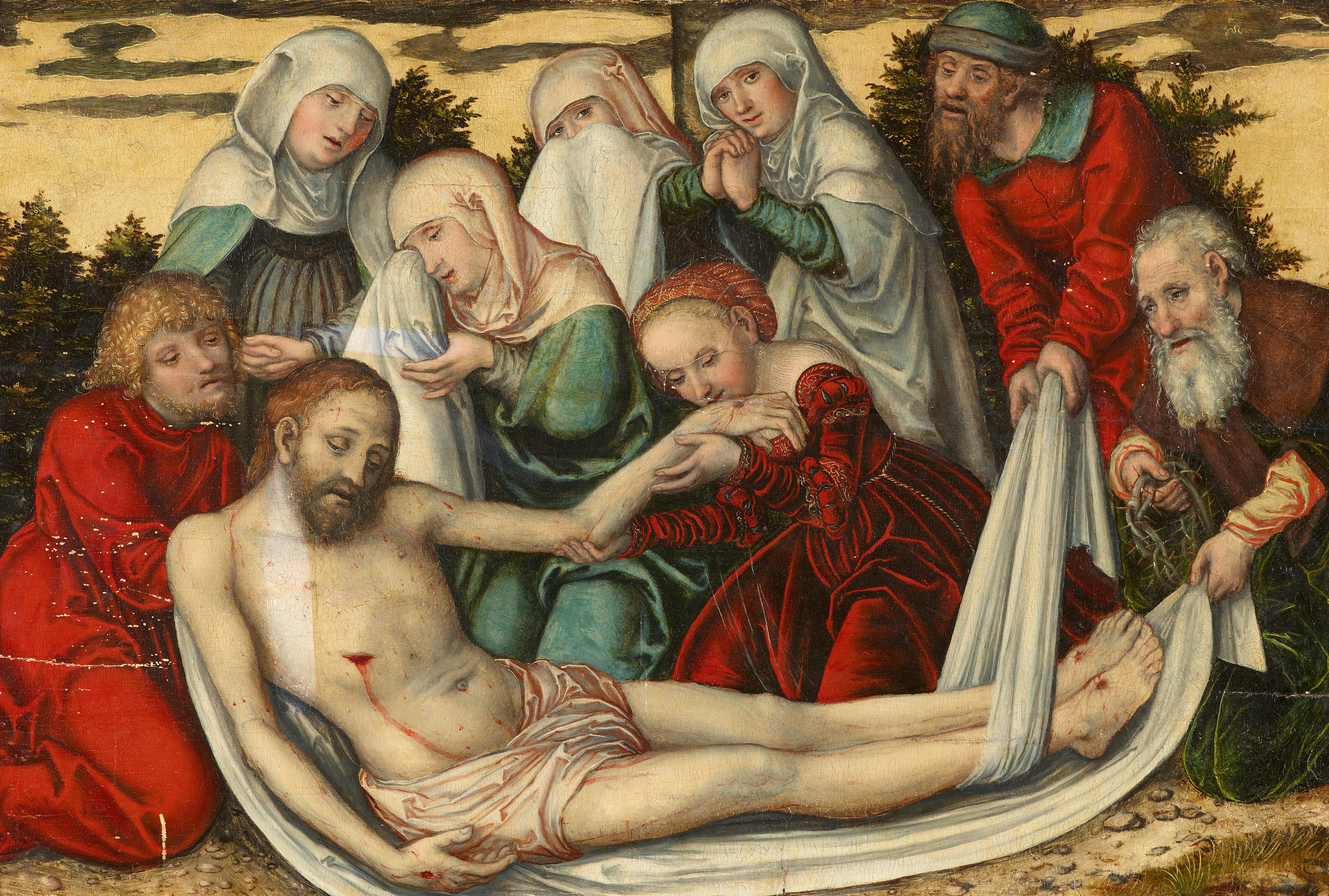Lucas Cranach the Elder, studio of
The Lamentation of Christ
Oil on panel. 48.4 x 73.1 cm.
Signed upper right: Snake signet with folded wings.
The body of Christ is shown laid on a white cloth. His upper body is supported by Saint John at the left edge of the picture. Mary Magdalene kneels in the centre and kisses Christ's left hand. Behind her, four weeping women with white veils mourn. In front of them and closest to Christ kneels Mary. On the right edge of the picture are Joseph of Arimathea and Nicodemus. The one holds the crown of thorns, the other a white cloth looped around Christ's limp legs.
For more than three decades, Lucas Cranach the Elder's workshop and his workshop painted the Lamentation of Christ in numerous variations after leaving the Wittenberg workshop. According to Dr. Gunnar Heydenreich, about 15 paintings are still known today based on the woodcut from 1509 (research report CICS, Cologne, 31.03.2023).
This "Lamentation of Christ" was already sold by Lempertz in 2004 as a late work by the elder Cranach, created in collaboration with his son. Since then, the painting has been in private hands. When it was presented to the public for the first time in 1935 in the Diözesanmuseum in Cologne, the press celebrated Cranach's hitherto completely unknown work enthusiastically: "The painting overwhelms with the magnificent momentum of its composition as much as it delights with the subtle delicacy of its style (...) The work, newly discovered for the art world, can be sure of the astonished and admiring sympathy of art lovers (...)".
Dr Dieter Koepplin, who examined the "Beweinung" in Basel, emphasises the high quality of the painting. In a 1989 letter to the owner at the time, he considers the work to be "executed by his own hand by Lukas Cranach the Elder or (more likely) the Younger around 1550." (see also note in the Koepplin Archive). The brushwork is "fresh, often astonishingly carefree, expressive and sure." According to Koepplin, a distinction between the works of the father and the son for the time around 1550 is hardly possible with certainty.
A technological examination of the panel by Professor Gunnar Heydenreich, CICS, TH Cologne, carried out in March 2023, helped to clarify the question of attribution. "Essential features of the substrate and the ground, the underdrawing, the painting materials and the painting technique (...) correspond to characteristic practices in the Wittenberg workshop of Lucas Cranach the Elder between c. 1540 and 1550." This allows the conclusion that "this work was created around 1540 in the workshop of Lucas Cranach the Elder" (investigation report CICS, Cologne, 31.03.2023). According to the report, a collaboration by the younger Cranach can be ruled out on the basis of various criteria: the "modelling of the flesh", "the form of the signet", which differs "from that used by Cranach the Younger after 1553 and for which there are already some examples in paintings from the 1540s." The "outstanding quality" of the painting "does not, however, achieve the overall mastery with which Lucas Cranach the Elder realised, for example, the "Lamentation of Christ" (1538) in Boston and other works. It is possible that the painting was created with a division of labour." It can therefore be assumed that the workshop was involved, despite the high quality of the work. The painting is listed in the Cranach Digital Archive under the number PRIVATE_NONE-P271.
Provenance
Private collection, Rhineland. - Swiss private collection. - Auctioned by Lempertz Cologne, 22.05.1004, lot 1033. - Subsequently in private ownership, Estonia.
Exhibitions
Diocesan Museum, Cologne, 1935.

